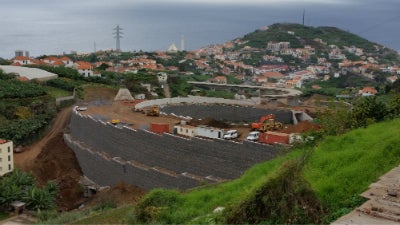
In order to connect the lower area of Camara de Lobos Strait with the main highway on the island of Madeira, it was necessary to create a new link road which would improve accessibility and road traffic conditions. Secondary roads in the area were also exhibiting significant signs of wear by the increasing traffic loads.
Known for its namesake wine and warm, subtropical climate, Madeira is a popular destination with tourists. Therefore, any solution considered by the client Estradas da Madeira needed to provide seamless integration with the surrounding landscape in addition to functionality.
Due to the island’s altitude and geometry, a tunnel and a viaduct was required to raise the road from the sea level to the existing motorway.
Numerous solutions were proposed by Maccaferri to the client, including mixed solutions of vegetating reinforced soil slopes in combination with rock faced structures. As the corridor available for construction was constrained (and to prevent additional appropriations) a Terramesh® solution with a steep front face was selected as the optimum solution. This combined the landscaping, aesthetics and transportation requirements.
The connecting road between the viaduct and tunnel would be built upon this soil reinforcement structure and would be about 400mlong. It would feature a symmetrical ‘back-to-back’ wall and be up to 20m high. Due to its great height, it was decided to construct a terrace of 2m width at half-height to reduce the visual impact of the wall.
Among the benefits of the modular Terramesh® system is that it is supplied in standard lengths, so no cutting was required on site. The system features a gabion fascia element with an integral mesh geogrid tail. The units are fabricated from heavily GalMac® galvanised and polymer-coated steel wire to provide a long design life. The fascia component of the Terramesh unit was filled with suitable gabion stone fill. Structural backfill was then placed upon the soil reinforcement geogrids and compacted.
The Terramesh® System was used in conjunction with Maccaferri’s high performance primary geogrids ParaLink® (used in the higher structures) and MacGrid® WG (used in the lower height structures).
The geogrid reinforcements bring strength to the soil enabling it to perform better than it would in its unreinforced state, enabling it to accommodate greater loads and stand at steeper angles.
ParaLink® is ideal in reinforced soil structures exposed to high loads because it available in ultra-high strengths, has an incredibly tough polyethylene sheath and is one of the most tried and tested geogrids in the market, having been used in reinforced soil for nearly 40 years. It is a bonded planar geogrid consisting of a monoaxial array of composite geosynthetic strips.
MacGrid® WG is made from high-molecular weight, and high-tenacity polyester multifilament yarns. The yarns are woven together and finished with a protective polymeric coating. Engineered to be mechanically and chemically durable, like the ParaLink® geogrid they are also resistant to biological degradation.
The reinforced soil structure has a face area of 11,000m² and construction was carried out between April and December 2015.










